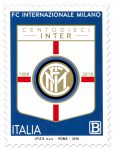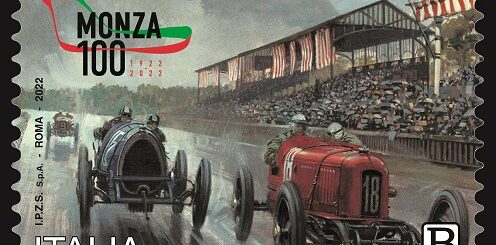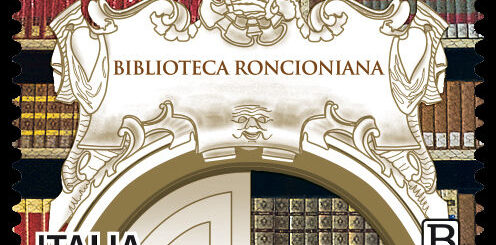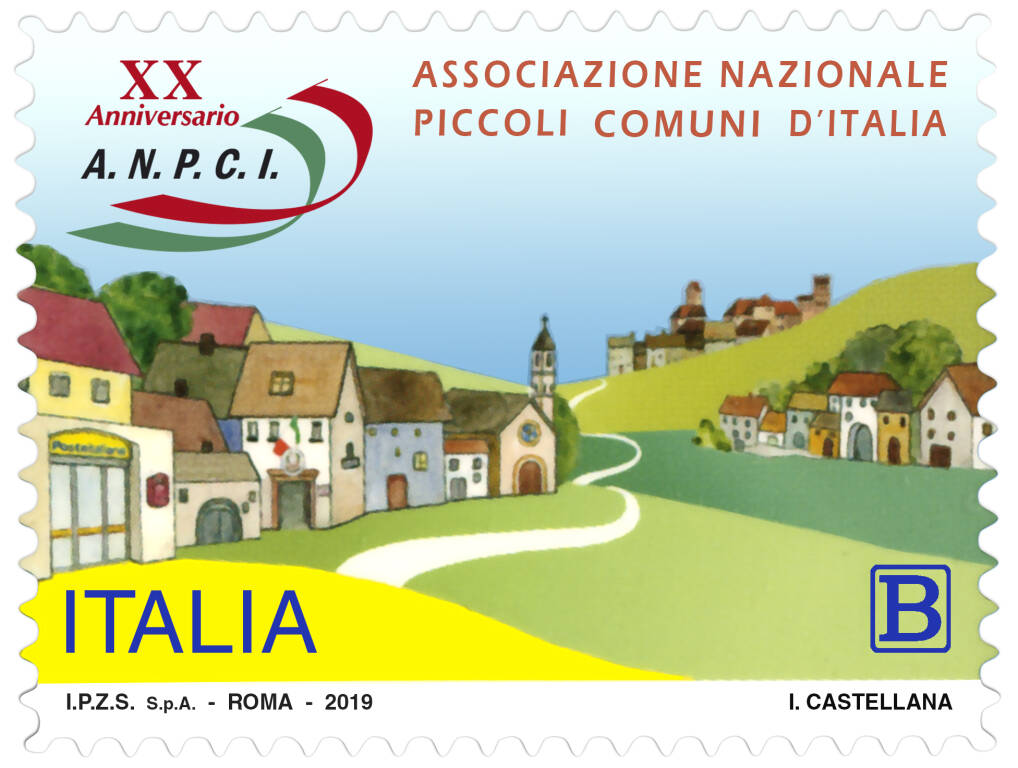POSTE ITALIANE – 33^ Emissione del 12 Ottobre 2018 – 110 ° Anniversario della fondazione della F.C. Internazionale Milano
 Titolo: 110° Anniversario della fondazione della F.C. Internazionale Milano
Titolo: 110° Anniversario della fondazione della F.C. Internazionale Milano
Il Ministero emette il 12 ottobre 2018 un francobollo ordinario appartenente alla serie tematica “lo Sport” dedicato al Football Club Internazionale Milano, nel 110° anniversario della fondazione.
Il Football Club Internazionale Milano, meglio conosciuto come Internazionale o più semplicemente come Inter, è una società calcistica per azioni italiana con sede a Milano.
Fondato nel 1908 da un gruppo di soci dissidenti del Milan, il club ha sempre militato nella massima serie del campionato nazionale dalla propria stagione di debutto, nel 1909, ed è l’unico ad aver partecipato a tutte le edizioni della Serie A, istituita nella stagione 1929-30. Fin dalla fondazione, indossa una divisa a strisce verticali nerazzurre, a parte una breve parentesi nel 1928 quando adottò una maglia bianca rossocrociata.
Nel suo palmarès annovera 30 titoli nazionali – 18 scudetti, 7 Coppe Italia e 5 Supercoppe italiane – che ne fanno il secondo club più titolato a pari merito con il Milan e alle spalle della Juventus . A livello internazionale vanta invece 3 Coppe dei Campioni/Champions League, 3 Coppe UEFA, 2 Coppe Intercontinentali e una Coppa del mondo per club FIFA, per un totale di 9 trofei ufficiali che pongono l’Inter dietro il Milan (18) e la Juventus (11) nella classifica dei club italiani per numero di vittorie in competizioni internazionali. Nel 2010 è diventata la prima e unica squadra italiana ad aver conquistato le tre competizioni principali (triplete) disputate nel corso della stagione: la Champions League, il campionato e la Coppa Italia; coi successivi trionfi in Supercoppa italiana e Coppa del mondo per club FIFA è diventata anche la prima, e, finora, unica squadra del Paese a vincere cinque trofei nell’arco di un anno solare.
Il club può contare su un sostegno numeroso sia a livello nazionale che internazionale. Nel 1998 e nel 2010 l’Inter fu nominata Squadra mondiale dell’anno dall’IFFHS; nel 2009 si piazzò al sesto posto nella lista secolare sui migliori club europei redatta dalla stessa federazione di storia e statistica, e nel 2011 al quinto posto (prima italiana) nella classifica mondiale delle migliori squadre del decennio 2001-2010.
Storia
Il Football Club Internazionale nacque la sera del 9 marzo 1908 al ristorante “Orologio” di Milano per iniziativa di un gruppo di soci dissidenti del Milan Football and Cricket Club, contrari al divieto imposto dal club rossonero di arruolare calciatori di nazionalità straniera. Giorgio Muggiani, uno dei 44 fondatori del nuovo club, scelse i colori che ne avrebbero caratterizzato il logo societario: il nero e l’azzurro, a rappresentare anche simbolicamente la rottura rispetto al passato. Giovanni Paramithiotti, un altro dei soci fondatori, fu scelto come presidente, lo svizzero Hernst Marktl passò invece alla storia come il primo capitano dei nerazzurri. Già due anni dopo la fondazione, nella stagione 1909-10, arrivò il primo titolo nazionale, conquistato sotto la guida di Virgilio Fossati — nella doppia veste di giocatore e allenatore — e la presidenza di Carlo De Medici. A questo successo seguirono risultati deludenti, fino allo scoppio della prima guerra mondiale che costrinse il campionato italiano a fermarsi.
Alla ripresa del torneo dopo la fine del conflitto bellico, nella stagione 1919-20, la squadra allenata da Francesco Mauro e Nino Resegotti centrò il suo secondo titolo nazionale. Nel 1928, per venire incontro alle direttive del regime fascista, la società nerazzurra fu costretta a fondersi con l’Unione Sportiva Milanese e cambiare denominazione in Società Sportiva Ambrosiana per ragioni politiche. Due anni dopo, nella stagione 1929-30, l’Ambrosiana vinse il primo campionato italiano disputato a girone unico, conquistato sotto la guida dell’ungherese Árpád Weisz, che a 34 anni divenne il tecnico più giovane a laurearsi campione. Intanto nel 1931, su iniziativa del presidente Ferdinando Pozzani, il club cambiò nuovamente denominazione e divenne noto come Ambrosiana-Inter. Il quarto tricolore venne conquistato nella stagione 1937-38 con Armando Castellazzi in panchina, mentre la successiva gestione dell’austriaco Tony Cargnelli portò in bacheca la prima Coppa Italia della storia interista, nell’annata 1938-39, e il quinto scudetto in quella 1939-40. Nel 1942, mentre la seconda guerra mondiale era ancora in corso, fu nominato presidente Carlo Masseroni, il quale nel 1945 annunciò il ritorno all’antica denominazione di Internazionale.
La squadra dovette attendere fino alla prima metà degli anni 1950 per tornare a primeggiare in Italia: guidata in panchina da Alfredo Foni, l’Inter vinse lo scudetto sia nella stagione1952-1953 che in quella 1953-1954, centrando un’inedita doppietta tricolore. Nel 1955 la società fu acquistata dal petroliere Angelo Moratti che, dopo i primi risultati non all’altezza delle aspettative, nella stagione 1960-61 scelse di affidare la panchina all’argentino Helenio Herrera: fu l’inizio dell’epopea della Grande Inter, una formazione leggendaria che nel giro di quattro anni vinse tre scudetti — compreso quello della stella nel 1965-66 — due Coppe dei Campioni e due Coppe Intercontinentali. La prima Coppa dei Campioni fu conquistata nel 1963-64, superando nella finale di Vienna il Real Madrid, la seconda arrivò invece l’anno dopo sconfiggendo a San Siro il Benfica. I due successi continentali furono seguiti in entrambi i casi dall’affermazione mondiale, con l’Inter capace di vincere la Coppa Intercontinentale sia nel 1964 — diventando la prima squadra italiana a riuscirci — che nel 1965, sempre contro l’Independiente.
Il 1968 segnò la fine di un ciclo, con Moratti che decise di passare la mano ad Ivanoe Fraizzoli. Sotto la sua presidenza, l’Inter tornò a vincere lo scudetto nella stagione 1970-71, guidata in panchina da Giovanni Invernizzi che divenne il primo tecnico nerazzurro a conquistare il titolo nazionale da subentrante. Nel 1977 fu ingaggiato Eugenio Bersellini, che rimase sulla panchina interista per cinque stagioni vincendo due Coppe Italia nel 1977-78 e nel 1981-82 e uno scudetto nel 1979-80.
Nel 1984 la società fu acquistata da Ernesto Pellegrini, che resterà in carica per poco più di un decennio. La squadra dovette però attendere ben nove anni prima di vincere nuovamente il campionato, nella stagione 1988-89, sotto la guida di Giovanni Trapattoni.[18] Durante la gestione di Trapattoni, arrivarono pure una Supercoppa italiana nel 1989 e una Coppa UEFA nel 1990-91, quest’ultima vinta contro la Roma. Negli anni successivi seguirono campionati deludenti, a cui fece da contraltare solo un altro successo in Coppa UEFA nel 1993-94, questa volta sugli austriaci del Salisburgo.
Nel 1995 si verificò una svolta epocale per la storia dell’Inter, quando Massimo Moratti decise di rilevare il club da Pellegrini, riportando — a distanza di 27 anni dal padre Angelo — un membro della famiglia Moratti al timone della società. Tuttavia, nonostante gli ingenti investimenti, i primi anni di presidenza Moratti regalarono poche soddisfazioni, se si eccettua il terzo successo in Coppa UEFA nella stagione 1997-98 contro la Lazio. Il club dovette attendere fino al 2004 per tornare a primeggiare in Italia, con l’arrivo in panchina di Roberto Mancini che aprì un nuovo ciclo di vittorie: risalgono infatti alla sua gestione la conquista di due Coppe Italia, nel 2004-05 e nel 2005-06, due Supercoppe italiane, nel 2005 e nel 2006, e tre scudetti — di cui il primo a tavolino per le vicende di Calciopoli — dal 2005-06 al 2007-08.
Chiusa l’esperienza di Mancini, Moratti ingaggiò il portoghese José Mourinho, che condusse la squadra alla vittoria in Supercoppa italiana nel 2008 e in campionato nel 2008-09, consentendo ai nerazzurri di raggiungere il Milan al secondo posto nell’albo d’oro della competizione. La stagione 2009-10 fu una tra le più gloriose nella storia del club: vincendo scudetto, Coppa Italia e Champions League, quest’ultima nella finale di Madrid contro il Bayern Monaco, i nerazzurri divennero la prima squadra italiana e tuttora unica a realizzare il treble. Nella stagione 2010-11, nella quale sedettero in panchina prima Rafael Benítez e poi Leonardo, il club vinse la Supercoppa italiana, la Coppa del mondo per club FIFA — centrando un inedito quintuple per il calcio italiano nel corso del 2010 — e la Coppa Italia.
Nel 2013, dopo diciotto anni di gestione Moratti, la società fu acquistata dall’imprenditore indonesiano Erick Thohir, che divenne così il primo presidente straniero della storia nerazzurra. Tuttavia la nuova proprietà non fu in grado di risollevare la società da una crisi di risultati nata al tramonto della precedente gestione e sostanzialmente proseguita nelle stagioni successive. Nel 2016 lo stesso Thohir cedette il controllo del club al Suning Holdings Group, di proprietà dell’imprenditore cinese Zhang Jindong.
Title: 110th Anniversary of the foundation of the F.C. Milan international
On October 12, 2018, the Ministry issued an ordinary stamp belonging to the thematic series “Lo Sport” dedicated to the Milan International Football Club, on the 110th anniversary of the foundation.
The International Football Club Milano, better known as International or more simply as Inter, is an Italian football club based in Milan.
Founded in 1908 by a group of dissident members of Milan, the club has always played in the top league of the national championship since its debut season, in 1909, and is the only one to have participated in all the editions of Serie A, established in 1929-30 season. Since the foundation, he wears a uniform with vertical stripes of Nerazzurri, apart from a brief interlude in 1928 when he adopted a white-red shirt.
In his palmarès includes 30 national titles – 18 league titles, 7 Italian Cups and 5 Italian Supercups – that make it the second most titled club with equal merit with Milan and behind Juventus. Internationally, it has 3 Champions League / Champions League Cups, 3 UEFA Cups, 2 Intercontinental Cups and a FIFA Club World Cup, for a total of 9 official trophies that put Inter behind Milan (18) and Juventus (11) in the ranking of Italian clubs by number of victories in international competitions. In 2010 it became the first and only Italian team to have conquered the three main competitions (triplete) played during the season: the Champions League, the championship and the Italian Cup; with the subsequent triumphs in the Italian Super Cup and the FIFA Club World Cup, it has also become the first, and so far, the only team in the country to win five trophies in a calendar year.
The club can count on numerous support both nationally and internationally. In 1998 and 2010, Inter was nominated World Team of the Year by the IFFHS; in 2009 he placed sixth in the secular list on the best European clubs drawn up by the same federation of history and statistics, and in 2011 ranked fifth (first Italian) in the world ranking of the best teams of the decade 2001-2010.
History
The International Football Club was born on the evening of March 9, 1908 at the restaurant “Clock” in Milan on the initiative of a group of dissident members of the Milan Football and Cricket Club, opposed to the ban imposed by the Rossoneri club to recruit players of foreign nationality. Giorgio Muggiani, one of the 44 founders of the new club, chose the colors that would have characterized the company logo: black and blue, to symbolically represent the break with respect to the past. Giovanni Paramithiotti, another of the founding members, was chosen as president, the Swiss Hernst Marktl instead passed to history as the first captain of the Nerazzurri. Already two years after the foundation, in the 1909-10 season, the first national title arrived, conquered under the guidance of Virgilio Fossati – in the double role of player and coach – and the chairmanship of Carlo De Medici. This success was followed by disappointing results, until the outbreak of the First World War that forced the Italian championship to stop.
At the resumption of the tournament after the end of the war, in the 1919-20 season, the team coached by Francesco Mauro and Nino Resegotti hit their second national title. In 1928, in order to meet the directives of the fascist regime, the Nerazzurri company was forced to merge with the Milanese Sports Union and change its name to the Ambrosian Sports Club for political reasons. Two years later, in the 1929-30 season, the Ambrosiana won the first Italian league in a single group, won under the guidance of the Hungarian Árpád Weisz, who at 34 became the youngest technician to graduate champion. Meanwhile, in 1931, at the initiative of President Ferdinando Pozzani, the club changed its name again and became known as Ambrosiana-Inter. The fourth tricolor was conquered in the 1937-38 season with Armando Castellazzi on the bench, while the subsequent management of the Austrian Tony Cargnelli brought in the showcase the first Italian Cup in the history of Inter, in the year 1938-39, and the fifth championship in 1939 -40. In 1942, while the Second World War was still in progress, Carlo Masseroni was appointed president, who in 1945 announced the return to the ancient name of Internazionale.
The team had to wait until the first half of the 1950s to return to excel in Italy: led by Alfredo Foni, Inter won the Scudetto both in the season 1952-1953 and in 1953-1954, centering an unprecedented double-barreled shotgun. In 1955 the company was bought by the oilman Angelo Moratti who, after the first results not up to expectations, in the 1960-61 season chose to entrust the bench to the Argentine Helenio Herrera: it was the beginning of the epic of the Great Inter, a legendary formation that won three championships within four years – including that of the star in 1965-66 – two Champions Cups and two Intercontinental Cups. The first European Cup was won in 1963-64, surpassing Real Madrid in the final in Vienna, the second came instead the year after defeating the Benfica at San Siro. The two continental successes were followed in both cases by the world affirmation, with Inter able to win the Intercontinental Cup both in 1964 – becoming the first Italian team to succeed – and in 1965, again against Independiente.
1968 marked the end of a cycle, with Moratti who decided to pass the hand to Ivanoe Fraizzoli. Under his chairmanship, Inter returned to winning the Scudetto in the 1970-71 season, led by Giovanni Invernizzi who became the first Nerazzurri coach to take the national title as a substitute. In 1977 Eugenio Bersellini was hired, who remained on the Inter bench for five seasons, winning two Italian Cups in 1977-78 and 1981-82 and a Scudetto in 1979-80.
In 1984 the company was bought by Ernesto Pellegrini, who will remain in office for just over a decade. However, the team had to wait a good nine years before winning the championship again, in the 1988-89 season, under the guidance of Giovanni Trapattoni. [18] During the management of Trapattoni, an Italian Super Cup arrived in 1989 and a UEFA Cup in 1990-91, the latter won against Roma. In the following years, disappointing championships followed, to which only another success in the UEFA Cup in 1993-94 was counterbalanced, this time on the Austrians of Salzburg.
In 1995 there was an epochal turning point for the history of Inter, when Massimo Moratti decided to take over the club from Pellegrini, reporting – after 27 years from his father Angelo – a member of the Moratti family at the helm of the company. However, despite the huge investments, the first years of presidency Moratti gave little satisfaction, except for the third success in the UEFA Cup in the 1997-98 season against Lazio. The club had to wait until 2004 to return to excel in Italy, with the arrival on the bench of Roberto Mancini who opened a new round of victories: in fact, the conquest of two Italian Cups in 2004-05 and 2005 -06, two Italian Supercups, in 2005 and 2006, and three championships – of which the first at the table for the events of Calciopoli – from 2005-06 to 2007-08.
After the experience of Mancini, Moratti hired Portuguese José Mourinho, who led the team to victory in the Italian Super Cup in 2008 and in the championship in 2008-09, allowing the nerazzurri to reach Milan in second place in the register of competition. The 2009-10 season was one of the most glorious in the club’s history: winning the Scudetto, the Italian Cup and the Champions League, the latter in the Madrid final against Bayern Munich, the Nerazzurri became the first Italian team and still unique to realize the treble. In the 2010-11 season, in which Rafael Benítez and then Leonardo sat down on the bench, the club won the Italian Super Cup, the FIFA Club World Cup – centering an unprecedented fivefold for Italian football during 2010 – and the Italian Cup .
In 2013, after eighteen years of managing Moratti, the company was bought by the Indonesian entrepreneur Erick Thohir, who thus became the first foreign president of the Nerazzurri history. However, the new property was not able to lift the company from a crisis of results born at the end of the previous management and substantially continued in the following seasons. In 2016, the same Thohir gave the club control to the Suning Holdings Group, owned by the Chinese entrepreneur Zhang Jindong.
| data /date | 12.10.2018 |
| n. catalogo / n. catalog | Michel 4070 – YT 3831- UN 3913 |
| dentellatura/Serration | 11 |
| stampa/printing | fustellatura – rotocalco |
| tipo di carta/paper type | bianca patinata neutra |
| stampato | I.P.Z.S. Roma |
| tiratura | 900.000 |
| fogli/sheet | 28 |
| dimensioni/dimensions | 30 x 40 mm |
| disegnatore /designer | |
| costo / price | B = €1.10 |






